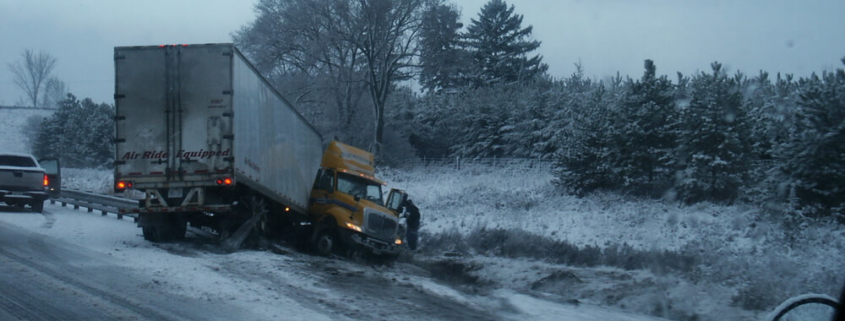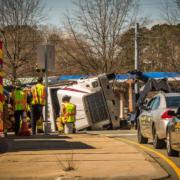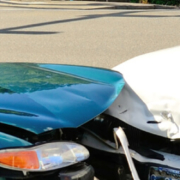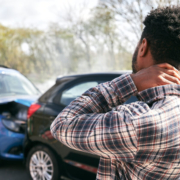Avoiding Winter Auto Accidents in West Virginia
Recently, a charter van carrying members of the Martinsburg High School girls basketball team rolled over while traveling on Interstate 64 in East Beckley, West Virginia. As the van entered the interstate on a sharp left-hand curve, it reportedly veered off onto the right-hand side of the road and overturned. The crash is still under investigation, but poor lighting on the interstate, road construction, and lack of familiarity with the road are believed to be contributing factors.
There were 12 students and two adults in the van, and thankfully, no one was seriously injured.
We are all very relieved that everyone involved in this accident appears to be okay. But unfortunately, this is far from an isolated incident. According to the Mountaineer News Service, West Virginia has a higher fatality rate from auto accidents than the national average. In the Mountain State, the number of car crash fatalities is 14.7 per 100,000 individuals. This is not only well above the national average, it is higher than surrounding states such as Ohio, Virginia, Pennsylvania, and Maryland.
There are many factors that contribute to West Virginia’s high auto accident fatality rate, these include:
- The mountainous terrain that is characteristic of the state;
- The numerous narrow and winding roads that are spread throughout the state;
- The high number of rural areas in the Mountain State;
- The high number of roads (throughout the state) that are poorly maintained;
- The high rates of driver negligence (e.g., speeding, reckless driving, distracted driving, drowsy driving, etc.) and impaired driving;
- Poor driving conditions, especially during the winter.
Tips for Safe Winter Driving in West Virginia
Even for the most experienced motorists, driving in West Virginia winter weather is a major challenge. In the mountainous regions, it is not uncommon to receive over 150 inches of snow during a typical winter. Even in the low-lying areas, you can expect to deal with several storm systems that deliver freezing rain, sleet, and snow throughout the season. Whatever part of the state you live in, it is important to be prepared for adverse winter driving conditions.
When the driving conditions are poor, it is best to stay off of the roads until conditions improve if at all possible. If you need to drive during inclement weather, however, here are some important things to keep in mind:
- Monitor your Tire Tread and Tire Pressure: Before you go out in poor weather, there are a few things you should take care of with your vehicle to make sure it is ready. One of the first is to check the tread and pressure on your tires. Be sure your tires have plenty of tread, and that they are inflated to the proper levels. If your tires are worn and there is very little tread left, there is a greater chance of slipping and sliding (or even having a blowout) if you hit ice or snow. If you have the budget, you may also want to consider investing in snow tires for the winter.
- Check your Battery: The last thing you want to happen is to get stranded in a remote area because of a dead battery. Check out your battery to make sure it has plenty of charge, and just in case, be sure to keep a set of jumper cables along with other emergency items in your vehicle.
- Check your Wipers and Washer Fluids: When rain or snow hits, you need to have wiper blades that are in good working order, as well as plenty of washer fluid. If your wiper blades are worn, replace them. Also, top off your washer fluid before going out and consider keeping extra washer fluid in your vehicle in case you need it.
- Clear the Snow Off of Your Vehicle: If you are going out after a snowstorm, make sure to clear all the snow off of your vehicle. Otherwise, this could cause visibility problems when you are driving.
- Drive Slowly: The best approach when driving in snowy and/or icy weather is to proceed slowly. The slower you are driving, the better you will be able to handle adverse conditions that may come up. It is generally best to drive below 45 miles per hour when you encounter snow or ice on the road.
- Keep a Safe Distance from Other Vehicles: Allow plenty of extra space between you and other vehicles on the road when there is freezing rain, snow, and similar conditions so you have enough time to slow down or stop if the vehicle in front of you starts to slide.
- Know How to Drive on Ice: If you are driving at a safe speed, it will be much easier to maintain control if your vehicle starts to skid or slide. If this happens, do not panic. Avoid slamming on your brakes as this can make existing slides worse. Turn your front wheels the same direction that the rear of your vehicle is sliding (this is commonly known as “turning into the slide”). While doing this, however, do NOT overcorrect with your turn as this can cause the vehicle to start rotating faster than the steer can counter, resulting in a spin out. This video provides a good explanation on how to do this properly.
Injured in a Car Accident in West Virginia? Secure your Legal Rights
Driving during winter weather in West Virginia is difficult, and sometimes, you may do everything right and still end up in an accident. If you or someone close to you was injured in a winter driving accident and it was the fault of another party, you have a right to compensation. When this happens, seek immediate medical attention, then contact an experienced personal injury attorney to discuss your legal rights and options. At Bailey, Javins, and Carter L.C., we have over 40 years of experience representing clients injured in motor vehicle accidents in West Virginia. We have in-depth knowledge of this area of the law, and we have a successful track record with even the most complex cases. To schedule a free consultation with one of our skilled attorneys, call our office today at (800) 497-0234 or (800) 296-6979, or send us a message through our online contact form.












